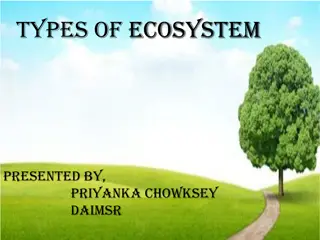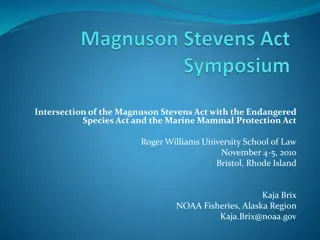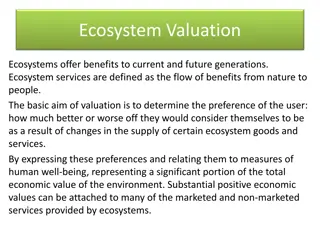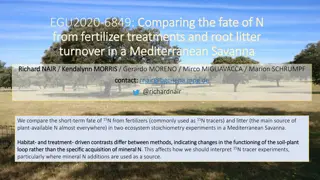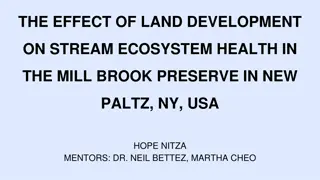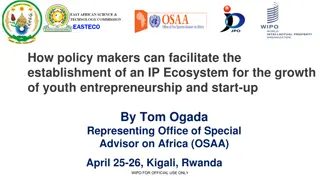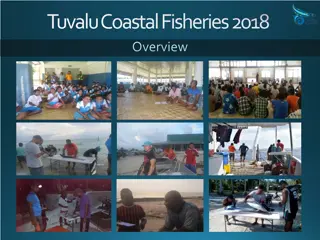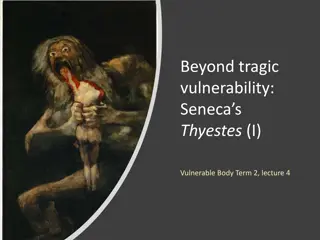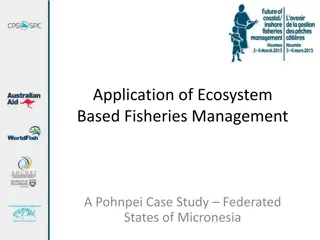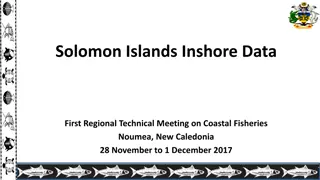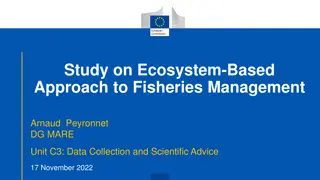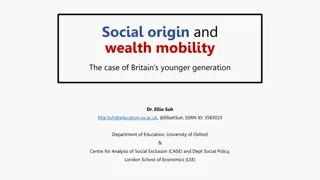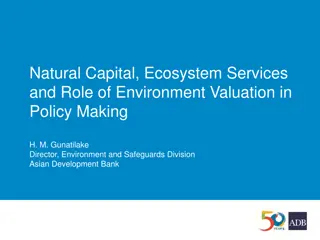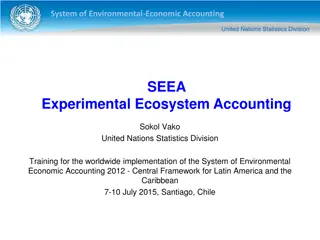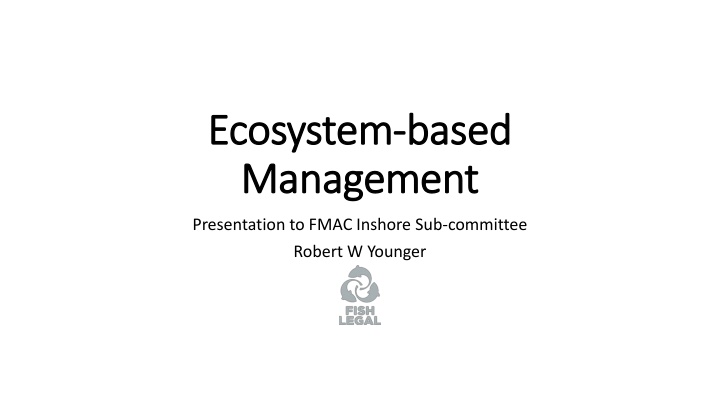
Ecosystem-Based Management in UK Marine Strategy Presentation
Explore the concepts and legal foundations of ecosystem-based management in the UK marine strategy, focusing on benthic habitats and the Programme of Measures. Understand the importance of managing ecosystems holistically for sustainability and resilience.
Download Presentation

Please find below an Image/Link to download the presentation.
The content on the website is provided AS IS for your information and personal use only. It may not be sold, licensed, or shared on other websites without obtaining consent from the author. If you encounter any issues during the download, it is possible that the publisher has removed the file from their server.
You are allowed to download the files provided on this website for personal or commercial use, subject to the condition that they are used lawfully. All files are the property of their respective owners.
The content on the website is provided AS IS for your information and personal use only. It may not be sold, licensed, or shared on other websites without obtaining consent from the author.
E N D
Presentation Transcript
Ecosystem Ecosystem- -based Management Management based Presentation to FMAC Inshore Sub-committee Robert W Younger
OUTLINE OF PRESENTATION OUTLINE OF PRESENTATION What is ecosystem-based management? Legal and policy basis UK Marine Strategy: the process Legal requirements for the Programme of Measures 2019 Assessment: where are we? A focus on benthic habitat Are the PoM for benthic habitat adequate Summary and Conclusion
WHAT IS ECOSYSTEM WHAT IS ECOSYSTEM- -BASED MANAGEMENT? BASED MANAGEMENT? Management that:- understands how ecosystems function and the relationships within them recognises and protects the diversity and productivity of ecosystem services protect the resilience of ecosystems recognises that management should occur at the correct geographic and temporal scale rejects single species approaches which fail to account for interactions within ecosystems
LEGAL AND POLICY BASIS LEGAL AND POLICY BASIS UN UN Convention on Biodiversity UNCLOS OSPAR Sustainable Goal 14 Marine Strategy Regulations 2010 UK Marine Strategy Marine Strategy Framework Directive 2008 Fisheries Act 2020 (UK) Joint Fisheries Statement (UK) Scotland s National Marine Plan Scotland s Biodiversity Strategy to 2045 Scotland s Fisheries Management Strategy 2020- 2030 RIFG Structure and function
MARINE STRATEGY: THE PROCESS MARINE STRATEGY: THE PROCESS Marine Strategy Part One: UK updated assessment and Good Environmental Status 2019 Marine Strategy Part Two: UK updated monitoring programmes 2021 Marine Strategy Part Three: UK Programme of Measures 2021
LEGAL REQUIRMENTS OF THE PROGRAMME LEGAL REQUIRMENTS OF THE PROGRAMME OF MEASURES OF MEASURES What is required by the Regulations: 14(1) By 31st December 2015 the competent authority must publish a programme of measures necessary to achieve or maintain good environmental status for marine waters in the marine strategy area, in accordance with Article 13 R14(5) the competent authority must include in the programme of measures a description of how the measures will be implemented and how they will contribute to the achievement of environmental targets established under regulation 12
2019 UPDATED ASSESSMENT 2019 UPDATED ASSESSMENT Ecosystem component High level objective GES Status 2019 Cetaceans The population abundance of cetaceans indicates healthy populations that are not significantly affected by human activities Partial Seals The population abundance and demography of seals indicates healthy populations that are not significantly affected by human activities Partial Birds The population abundance and demography of birds indicates healthy populations that are not significantly affected by human activities Fail Fish The population abundance and demography of fish indicates healthy populations that are not significantly affected by human activities Fail Pelagic habitats Pelagic habitats are not significantly adversely affected by human activities Partial Benthic habitats The health of seabeds is not significantly adversely affected by human activities Fail Fail Non Indigenous species The rate of introduction of NIS, spread and impact of NIS caused by human activities is not adversely altering ecosystems Commercial fish Populations of all commercially exploited fish and shellfish are within safe biological limits exhibiting a population age and size distribution that is indicative of a healthy stock Fail Food Webs The health of the marine food web is not significantly adversely affected by human activities Partial
GES: threshold values for benthic ecosystem component GES: threshold values for benthic ecosystem component TARGETS Physical loss of each seabed habitat type caused by human activities is minimised and where possible reversed The extent of habitat types adversely affected by physical disturbance caused by human activity should be minimised INDICATOR Physical loss of predicted habitat THRESHOLD VALUE Extent of physical damage indicator The area of seafloor in poor condition is less than 15% for each assessment area OSPAR Benthic communities indicator OSPAR The area of habitat in poor condition must not exceed 15% of total available habitat area Habitat loss of sensitive fragile or important habitats caused by human activities is prevented and where feasible reversed Physical loss of predicted habitats indicator Extent and distribution of sensitive or representative seabed habitats is stable and or increasing and not smaller than a baseline value for listed habitats The extent of adverse effects caused by human activities on the condition and function and ecosystem processes of habitats is minimised Benthic communities indicator OSPAR Aggregated infaunal quality index Aggregated saltmarsh tool Aggregated intertidal seagrass tool Intertidal rock community change indicator Damaging human impacts on predominant sediment habitats (biotic and abiotic components) individually and cumulative are reduced: the extent of adverse effects on the condition of habitats and associated ecological process caused by human activities is reduced and precautionary principle is applied to the most sensitive habitat types and or those which are most important for ecosystem functioning and ecosystem services.
Extent of Physical Disturbance to Benthic Habitats - Scottish Marine Assessment Scottish Marine Region (SMR) No predicted disturbance Low disturbance (categories 1-4) High disturbance (categories 5-9) Status Solway 12% 66% 22% Clyde 8% 26% 65% Argyll 20% 36% 44% West Highlands 8% 27% 65% Outer Hebrides 36% 31% 33% North Coast 5% 46% 49% Orkney Islands 10% 48% 41% Shetland Isles 4% 16% 80% Moray Firth 9% 34% 57% North East 5% 44% 51% Forth and Tay 13% 39% 48%
GES biogenic habitats indicator GES biogenic habitats indicator Scottish Marine Assessment Assessment Scottish Marine Scottish Marine Region Habitat (% loss) Total loss (ha) Target met Blue mussel Flame shell Horse mussel Maerl Seagrass Serpulid aggs Forth and Tay ? - ? - ? - ? ? North East - - - - - - ? ? Moray Firth 99.5 - Stable - ? - 217 No Orkney Islands - ? ? ? ? - ? ? Shetland Isles ? - ? ? ? - ? ? North Coast - - - ? - - ? ? West Highlands ? <1 ? ? ? >90 20 No
Do the proposed measures for benthic health Do the proposed measures for benthic health meet the requirements of the Regulations? meet the requirements of the Regulations? Proposed Measures for GES for Benthic Health 2021 Comment Fisheries Act/Fisheries Management Plans Unclear how these will operate to deliver ecosystem-based management particularly as it would appear at the moment that Scot Gov appears to be developing single species plans Working Group to identify solutions Status unknown MPA/PMF management measures Unclear whether the extent of measures in the most disturbed habitats (burrowed mud) will be sufficient HPMAs Not being progressed Inshore Cap Unclear how a measure designed to freeze the footprint of commercial fishing in inshore can deliver material reductions in disturbance
CONCLUSIONS CONCLUSIONS Ecosystems require a broad focus on ecosystem health Ecosystem-based management is legal and policy requirement There is a process in place to deliver called the Marine Strategy Most recent assessment shows Scotland failing on GES A focus on benthic habitat shows a huge gap between current fishery practice and ecosystem-based management We do not believe the current programme of measures for benthic health meet the legal requirements of the Marine Strategy Regulations We advise that the Scottish Government use this Group to assist in identifying measures to ensure Scotland delivers ecosystem-based management.

